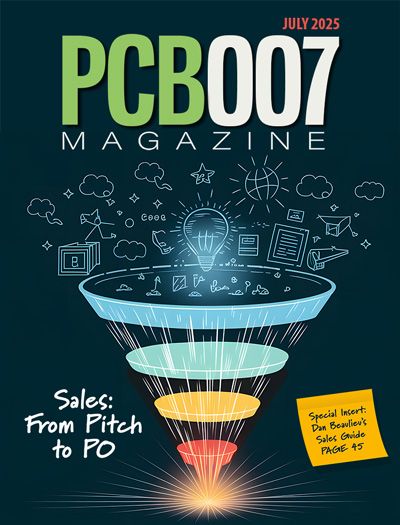-

- News
- Books
Featured Books
- pcb007 Magazine
Latest Issues
Current Issue
Advancing the Advanced Materials Discussion
Moore’s Law is no more, and the advanced material solutions to grapple with this reality are surprising, stunning, and perhaps a bit daunting. Buckle up for a dive into advanced materials and a glimpse into the next chapters of electronics manufacturing.

Inventing the Future With SEL
Two years after launching its state-of-the-art PCB facility, SEL shares lessons in vision, execution, and innovation, plus insights from industry icons and technology leaders shaping the future of PCB fabrication.

Sales: From Pitch to PO
From the first cold call to finally receiving that first purchase order, the July PCB007 Magazine breaks down some critical parts of the sales stack. To up your sales game, read on!
- Articles
- Columns
- Links
- Media kit
||| MENU - pcb007 Magazine
New Design Strategy Can Help Improve Layered Superconducting Materials
October 14, 2019 | Tokyo Metropolitan UniversityEstimated reading time: 2 minutes
Scientists from Tokyo Metropolitan University have created a new layered superconducting material with a conducting layer made of bismuth, silver, tin, sulfur and selenium. The conducting layer features four distinct sublayers; by introducing more elements, they were able to achieve unparalleled customizability and a higher "critical temperature" below which superconductivity is observed, a key objective of superconductor research. Their design strategy may be applied to engineer new and improved superconducting materials.
Once an academic curiosity, superconductors are now at the cutting edge of real technological innovations. Superconducting magnets are seen in everyday MRI machines, particle accelerators for medical treatments, not to mention the new Chuo Shinkansen maglev train connecting Tokyo to Nagoya currently being built. Recently, a whole new class of "layered" superconducting structures have been studied, consisting of alternate layers of superconducting and insulating two-dimensional crystalline layers. In particular, the customizability of the system has garnered particular interest in light of its potential to create ultra-efficient thermoelectric devices and a whole new class of "high temperature" superconducting materials.
A team led by Associate Professor Yoshikazu Mizuguchi from Tokyo Metropolitan University recently created a bismuth sulfide based layered superconductor; their work has already revealed novel thermoelectric properties and an elevated "critical temperature" below which superconductivity is observed. Now, working with a team from the University of Yamanashi, they have taken a multi-layered version of the system, where the conducting layer consists of four atomic layers, and begun swapping out small proportions of different atomic species to probe how the material changes.
Starting with a conducting layer made of bismuth, silver and sulfur, they tried substituting some of the silver for tin. By varying the amount of silver, they were able to raise the critical temperature from 0.5K to above 2.0K. Interestingly, they found that this was accompanied by the disappearance of an anomaly in its resistivity at significantly higher temperatures. Though the reason behind this is not yet understood, it is clear that the addition of tin has significantly modified the electronic structure of the material. Furthermore, they took their best bismuth, silver, sulfur and tin combination and substituted some of the sulfur for selenium, a modification known to improve superconducting properties in their original bismuth sulfide material. Not only did they raise the critical temperature further to 3.0K, they found that the response to magnetic fields showed signatures of "bulk" superconductivity, providing clear proof that they could in fact access both the advantages of reduced dimensionality and bulk materials.
By changing the composition and number of layers, the team believe they are on the verge of achieving bottom-up engineering of new, tailored bismuth sulfide based superconducting materials.
Testimonial
"We’re proud to call I-Connect007 a trusted partner. Their innovative approach and industry insight made our podcast collaboration a success by connecting us with the right audience and delivering real results."
Julia McCaffrey - NCAB GroupSuggested Items
Meet the Author Podcast Features Dr. Pritha Choudhury
09/24/2025 | I-Connect007I-Connect007 announces the latest episode of its Meet the Author podcast series, spotlighting Dr. Pritha Choudhury, a co-author of The Printed Circuit Assembler’s Guide to Low-temperature Soldering, Volume 2. In this conversation with SMT007 Managing Editor Nolan Johnson, Dr. Choudhury explains why a second volume was essential and explores the real-world factors accelerating the adoption of low-temperature soldering across the electronics manufacturing industry.
ROHM Develops Ultra-Compact CMOS Op Amp: Delivering Industry-Leading Ultra-Low Circuit Current
09/11/2025 | ROHMROHM’s ultra-compact CMOS Operational Amplifier (op amp) TLR1901GXZ achieves the industry’s lowest operating circuit current.
Indium Corporation to Highlight High-Reliability Solder Solutions at SMTA Guadalajara Expo
09/04/2025 | Indium CorporationIndium Corporation, a leading materials refiner, smelter, manufacturer, and supplier to the global electronics, semiconductor, thin-film, and thermal management markets, will feature a range of innovative, high-reliability solder products for printed circuit board assembly (PCBA) at the SMTA Guadalajara Expo and Tech Forum, to be held September 17-18 in Guadalajara, Mexico.
INEMI Interim Report: Interconnection Modeling and Simulation Results for Low-Temp Materials in First-Level Interconnect
05/30/2025 | iNEMIOne of the greatest challenges of integrating different types of silicon, memory, and other extended processing units (XPUs) in a single package is in attaching these various types of chips in a reliable way.
Laird Thermal Systems Unveils New Identity
05/05/2025 | Laird Thermal SystemsLaird Thermal Systems, a global leader in active thermal management solutions with more than 60 years of application expertise, today announced its rebrand to Tark Thermal Solutions.


